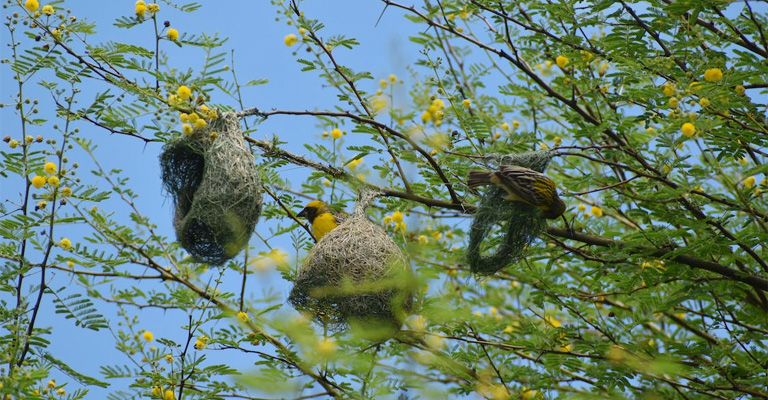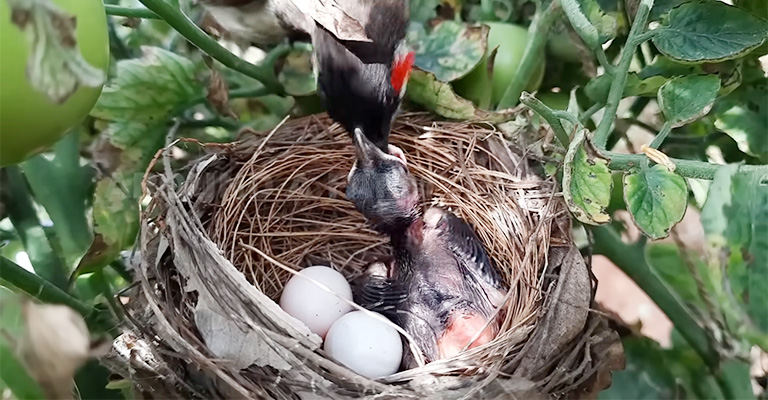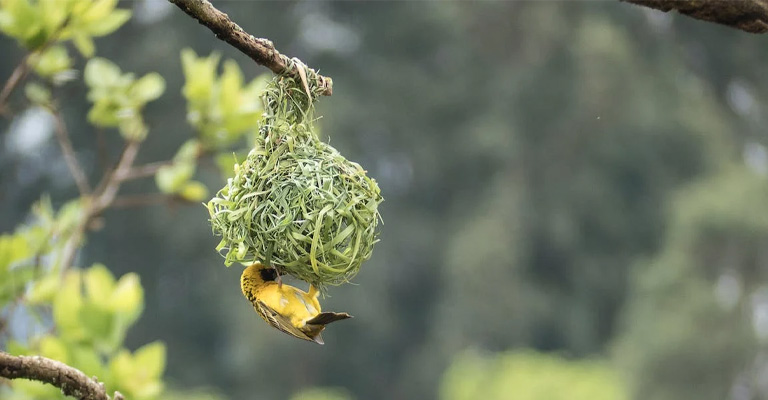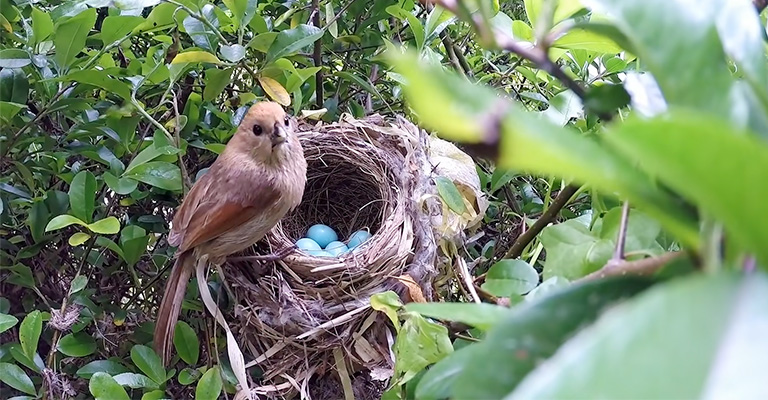Birds, with their vibrant plumage and melodious songs, have long captivated our attention and curiosity. One of the most intriguing aspects of avian behavior is their choice of nesting sites, particularly their preference for trees.
From the towering giants of the rainforest to the humble branches of suburban backyards, trees serve as the favored abode for countless bird species across the globe. But why do birds make their nests in trees?
In this article, we delve into the reasons behind this remarkable phenomenon. We explore the advantages trees offer in terms of safety, protection, and accessibility for nesting birds.
Additionally, we uncover the other locations where birds often make their nests. So, let’s embark on a journey into the avian world and unravel the secrets behind why birds make their nests in trees.

Why Do Birds Make Their Nests on Trees?
Birds make their nests in trees for several reasons. From reducing competition to regulating temperature and enhancing visibility, trees play a crucial role in supporting the nesting behaviors and survival of various bird species. Here are the detailed explanations:
Protection
Trees provide a natural shelter for birds’ nests, offering protection from predators. The height and structure of trees make it difficult for ground-dwelling predators to reach the nests, ensuring the safety of the eggs and chicks.
Camouflage
Many bird species have evolved to blend in with the surrounding foliage, making their nests less visible to potential threats. The leaves, branches, and bark of trees provide excellent camouflage, helping to conceal the nests and keep them hidden from their predators.
Accessibility
Trees offer a convenient location for birds to build their nests. The branches and twigs provide a sturdy framework for constructing the nest, and the vertical structure of the tree allows birds to easily access their nests without much effort.
Food Availability
Trees attract a variety of insects, fruits, and seeds, which serve as a food source for many bird species.
By building their nests on trees, birds can take advantage of the nearby food resources, ensuring a steady supply of nourishment for themselves and their offspring.
Nest Stability
Trees provide a stable foundation for bird nests. The branches and trunk offer a secure structure that can withstand wind, rain, and other environmental factors.
This stability is crucial for the survival of the eggs and chicks, as it reduces the risk of the nest being dislodged or damaged.
Nesting Site Competition

Trees provide a vast array of nesting sites, allowing multiple bird species to coexist in the same area.
Different species can occupy different parts of the tree, such as the branches, trunk, or even tree cavities, minimizing competition for nesting space.
Temperature Regulation
Trees offer a microclimate that helps regulate the temperature inside the nest. The shade provided by the tree’s canopy helps keep the nest cool during hot summer days, while the dense foliage can provide insulation and protection from cold temperatures during winter.
Nest Visibility
Building nests on trees can enhance the visibility of the nest to potential mates or other members of the bird’s species.
This visibility can play a role in courtship displays, territorial defense, and social interactions among birds.
Nest Reuse
Many bird species reuse their nests from year to year. By building nests on trees, birds can take advantage of the existing structure, saving time and energy in constructing a new nest each breeding season.
Nest Sanitation
Trees offer a natural way to keep nests clean. The wind, rain, and natural decay processes in trees can help remove debris, parasites, and waste materials from the nest, maintaining a healthier environment for the birds and their offspring.
Overall, trees offer birds a combination of protection, camouflage, accessibility, food availability, and nest stability, making them an ideal location for building nests.
How Do Birds Build Nests on Trees?

Birds build nests on trees using a variety of techniques and materials. The specific method and materials used can vary depending on the bird species, but here is a general overview of how birds build nests on trees:
Selecting a Site
Birds carefully choose the location for their nest on a tree. This can be a branch, fork, or even a tree cavity. Site selection is influenced by factors such as protection from predators, accessibility, and stability.
Collecting Materials
Birds gather various materials to construct their nests. Common materials include twigs, leaves, grass, moss, feathers, and even spider silk. Some birds may also incorporate mud, bark, or lichens into their nests for added strength and camouflage.
Building the Framework
Birds typically start by creating a framework for their nests using twigs and small branches. They interweave and arrange these materials to form a sturdy base. The size and shape of the nest can vary depending on the bird species.
Adding the Lining
Once the framework is in place, birds add a soft lining to the nest. This lining can consist of materials like grass, feathers, fur, or plant fibers. The lining provides insulation and comfort for the eggs and chicks.
Securing the Nest
Birds use various techniques to secure their nests to the tree. They may weave the nest into the branches, use spider silk or other sticky substances to attach it, or even wedge it into a tree cavity. The goal is to ensure the nest remains stable and doesn’t easily dislodge.
Nest Maintenance
Throughout the nesting period, birds may make repairs or additions to their nests as needed. They may reinforce weak spots, replace damaged materials, or adjust the nest structure to accommodate growing chicks.
It’s important to note that the nest-building process can vary significantly among bird species. Some birds, like woodpeckers, excavate cavities in trees for nesting, while others, like weaverbirds, construct intricate woven nests.
The size, shape, and materials used in nests can also differ based on the bird’s size, habitat, and specific nesting requirements.
Do All Birds Make Nests on Trees?

No, not all birds make nests in trees. While many bird species do build their nests on trees, some birds choose other nesting locations based on their specific adaptations and habitat preferences. Here are a few examples:
Ground-Nesting Birds
Some bird species, such as shorebirds like plovers and sandpipers, prefer to nest on the ground. They create shallow depressions in the soil or sand, often in open areas like beaches, grasslands, or tundra.
Cliff-Nesting Birds
Certain bird species, like cliff swallows and peregrine falcons, build their nests on cliffs or rocky ledges. These birds use mud, grass, and other materials to construct their nests, taking advantage of the vertical surfaces for protection and accessibility.
Burrow-Nesting Birds
Birds like burrowing owls and kingfishers excavate burrows in the ground or use existing burrows created by other animals. These birds create chambers within the burrows where they lay their eggs and raise their young.
Cavity-Nesting Birds
Some birds, such as woodpeckers, owls, and bluebirds, nest in tree cavities or holes in other structures like buildings or cliffs. These birds rely on natural cavities or create their own by excavating wood or modifying existing holes.
Nesting on Man-Made Structures
Certain bird species have adapted to nest on man-made structures like buildings, bridges, or utility poles. Examples include pigeons, swallows, and house sparrows, which construct nests in nooks, ledges, or specially designed nesting platforms.
Burrow-Nesting Seabirds
Birds like puffins, petrels, and shearwaters nest in burrows dug into the soil or cliffs on coastal or island habitats. These burrows protect from predators and harsh weather conditions.
Ground-Nesting Waterfowl
Birds such as ducks, geese, and swans often build their nests on the ground near bodies of water, such as marshes, ponds, or lakes. They create nests using vegetation and down feathers, usually in concealed locations to minimize predation risk.
Floating-Nesting Birds
Some bird species, like grebes and coots, construct floating nests on the water’s surface. They use aquatic vegetation and other materials to create floating platforms that provide stability and protection for their eggs and chicks.
Weaverbirds
Weaverbirds, found primarily in Africa and Asia, are known for their intricate woven nests. They construct elaborate nests made of grass, leaves, and other plant materials, often suspended from tree branches or built near water bodies.
Rock-Nesting Birds
Certain bird species, such as the American dipper and the European rock pipit, build their nests on rocky outcrops or cliffs. They create cup-shaped nests using moss, grass, and other materials, taking advantage of the rocky terrain for protection.
FAQs
The time it takes for birds to build a nest can vary depending on the species and the complexity of the nest. Some birds can construct a simple nest in just a few days, while others may take several weeks to build more intricate nests.
Yes, many bird species reuse their nests from year to year. They may make repairs or additions to the existing nest or simply use it as a foundation for a new nest. This behavior saves time and energy in constructing a new nest each breeding season.
Nest-building behavior is instinctual for birds. They have innate knowledge and genetic programming that guides them in constructing nests. However, some aspects of nest-building can be influenced by observation and learning from other birds in their social group.
After the breeding season, bird nests can serve various purposes. Some nests may be abandoned and left to deteriorate naturally. Others may be reused by other bird species or repurposed by animals like squirrels or insects.
Yes, you can help birds by providing nesting materials in your backyard. Offer materials like twigs, grass clippings, small branches, and pet fur in a designated area. Birds may use these materials to supplement their nest-building efforts, especially during the breeding season.
Final Words
The choice of trees as nesting sites for birds is a testament to the remarkable adaptability and resourcefulness of these winged creatures.
Trees provide a multitude of benefits, including protection from predators, shelter from the elements, and a stable foundation for their delicate nests. Furthermore, the evolutionary history of birds and trees has intertwined over time, leading to a mutualistic relationship that benefits both parties.
As we continue to marvel at the intricate nests perched high above our heads, let us appreciate the intricate bond between birds and trees and the vital role they play in maintaining the delicate balance of our ecosystems.
So, the next time you spot a bird’s nest nestled among the branches, take a moment to ponder the wonders of nature and the harmonious coexistence between these aerial architects and their leafy hosts.